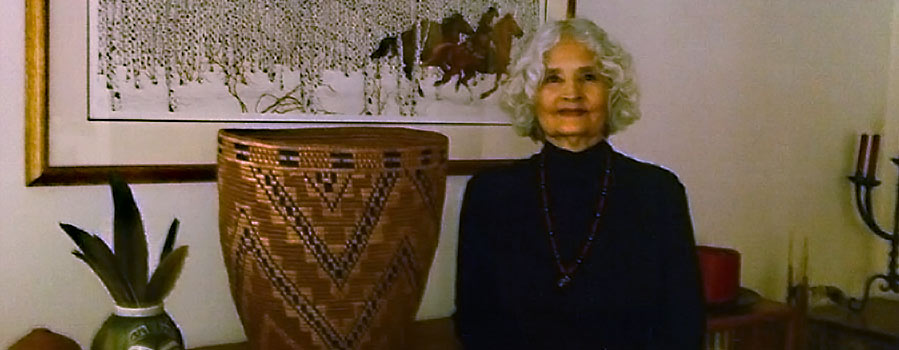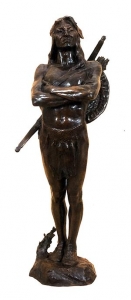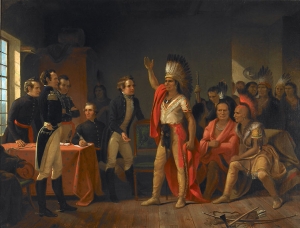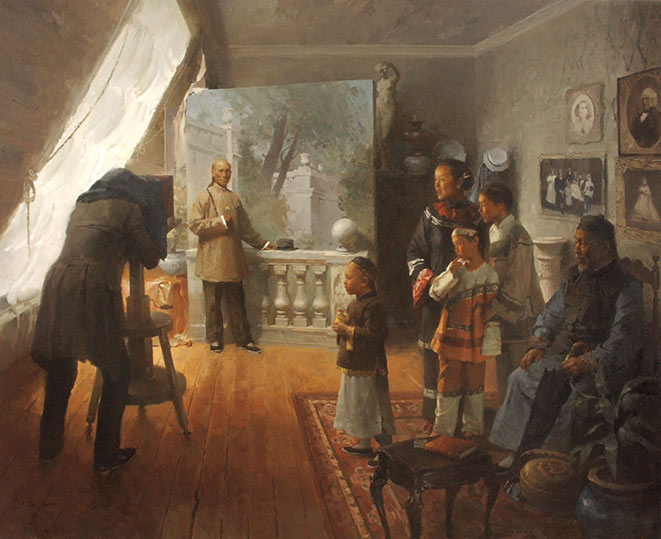
Jeri-Marie Bennett
Jeri-Marie Bennett is a Lummi Elder. She was raised in Puyallup, where she now resides, and attended Bellevue College and the University of Washington. During her long involvement with the local Native American community, she has served as Program Manager at the Seattle Indian Center, co-creator of Life Quest, Volunteer Guardian Ad Litem for King County Juvenile Court, founding member of the Indian Child Welfare Coalition, President of the Ethnic Heritage Council of the Pacific Northwest, and in many other positions. She is currently writing about Indian boarding schools in Washington and Oregon. Jeri-Marie is a lifelong patron of the arts and is a member of TAM.
What are your thoughts on our exhibition Art of the American West?
I like seeing the case of Native American glass art right outside the exhibition. It is a reminder to visitors that Native people are still here and are working in all kinds of contemporary media. We are not just in the past.
 When entering the gallery, I loved seeing all the bronzes in the sculpture hall. The bronze really glows in the natural light. It is the introduction to the exhibition but it is also an introduction to the story of this region. The sculptures reflect the raw energy and strength it took to settle and live in the American West. Some of the works are very sad. Here is a Native man with his arms open praying to his higher power because life had become so hard. The bronze buffalo at the entrance met its demise when the train, the iron horse, and railways came through, which led to starvation for many Native people. I enjoyed seeing the image of the Native man from the Multnomah people at the end of the hall. He is so very proud. He was never beaten down, he is still standing tall. That bronze might make some people uncomfortable.
When entering the gallery, I loved seeing all the bronzes in the sculpture hall. The bronze really glows in the natural light. It is the introduction to the exhibition but it is also an introduction to the story of this region. The sculptures reflect the raw energy and strength it took to settle and live in the American West. Some of the works are very sad. Here is a Native man with his arms open praying to his higher power because life had become so hard. The bronze buffalo at the entrance met its demise when the train, the iron horse, and railways came through, which led to starvation for many Native people. I enjoyed seeing the image of the Native man from the Multnomah people at the end of the hall. He is so very proud. He was never beaten down, he is still standing tall. That bronze might make some people uncomfortable.
The Haub’s collection is very interesting. There were several pieces that surprised me, like the portrait of General George Washington. When I first came around the corner and saw it, I laughed! Many of the representations are probably not accurate to Native life, but they collected what they loved and I’m glad that they shared it with us.
What can we learn from western American art?
 Western American art can help us understand history. Some of that history is good, some of it is bad. Some of these paintings defy expectations. Look at the Tecumseh portrait. He is strong and bold, he dominates. He is standing proudly speaking to a group of white Americans and it looks like they are actually listening to what he says. There are also paintings showing trade scenes and calm interactions between Natives and westerners, their weapons are relaxed. Native Americans weren’t always attacking settlers to protect their territories, a lot of times they trusted and helped the newcomers to the area. In some of the paintings you can also see Native Americans playing games, going about their daily lives, instead of only showing violence or warfare like in a lot of other western art.
Western American art can help us understand history. Some of that history is good, some of it is bad. Some of these paintings defy expectations. Look at the Tecumseh portrait. He is strong and bold, he dominates. He is standing proudly speaking to a group of white Americans and it looks like they are actually listening to what he says. There are also paintings showing trade scenes and calm interactions between Natives and westerners, their weapons are relaxed. Native Americans weren’t always attacking settlers to protect their territories, a lot of times they trusted and helped the newcomers to the area. In some of the paintings you can also see Native Americans playing games, going about their daily lives, instead of only showing violence or warfare like in a lot of other western art.
What are your thoughts on the portrayals of Native people in our collection?
When looking at art you have to think about the lives of the artists. What was their market, did they have a patron back on the East Coast? We don’t know about the artists and what they went through. Many of these artists might have had struggles that we are not aware of. They may have made more sensitive images of Native Americans or other people for themselves, but those images might not have sold.
The railroads and land developers in the East commissioned artists to portray the West in territorial vistas or landscapes to encourage settlement by Euro-Americans west of the mighty Missouri. Then you had the artists who came out here to capture the West before European settlement and probably captured more of the Native culture because they were sensitive to the fact that the West was already settled.
Maybe there aren’t many images of women in this artwork, and in a lot of historical artwork, because the artists weren’t around many women in the West or because that subject matter didn’t sell unless the woman was very beautiful. I am also glad to see the Mian Situ painting, even though the Chinese were here in the West historically, they weren’t usually painted.
 What is the relationship between the West and the Northwest?
What is the relationship between the West and the Northwest?
For Native people there has always been a trade connection between the Northwest and the West. At The Dalles on the Columbia River in Oregon there was a busy trade site that brought together goods and people from the Plateau, Northwest Coast, Plains, Oregon, and Northern California tribes. Different cultures came together here. I think you can show that the West is relevant to the Northwest by connecting this exhibition with future shows. Whether you can rely on the artists’ interpretations being accurate or not, seeing this collection helps us know about American history, which we are all a part of.
Image credits (top to bottom): Image of Jeri-Marie Bennett courtesy of Jeri-Marie Bennett. Hermon Atkins MacNeil (American, 1866-1947), A Chief of the Multnomah Tribe, modeled 1907; cast 1912‑1914. Bronze 31 ½ í— 13 í— 12 inches. Tacoma Art Museum, Haub Family Collection, Gift of Erivan and Helga Haub. Junius Brutus Stearns (1810–1885), The Meeting of Tecumseh and William Henry Harrison at Vincennes, 1851. Oil on canvas, 33â…œ í— 43â…œ inches. Tacoma Art Museum, Haub Family Collection, Gift of Erivan and Helga Haub. Mian Situ (Chinese-American, born 1953), The Entrepreneur—San Francisco, 2006. Oil on canvas, 44 í— 54 inches. Tacoma Art Museum, Haub Family Collection, Gift of Erivan and Helga Haub.